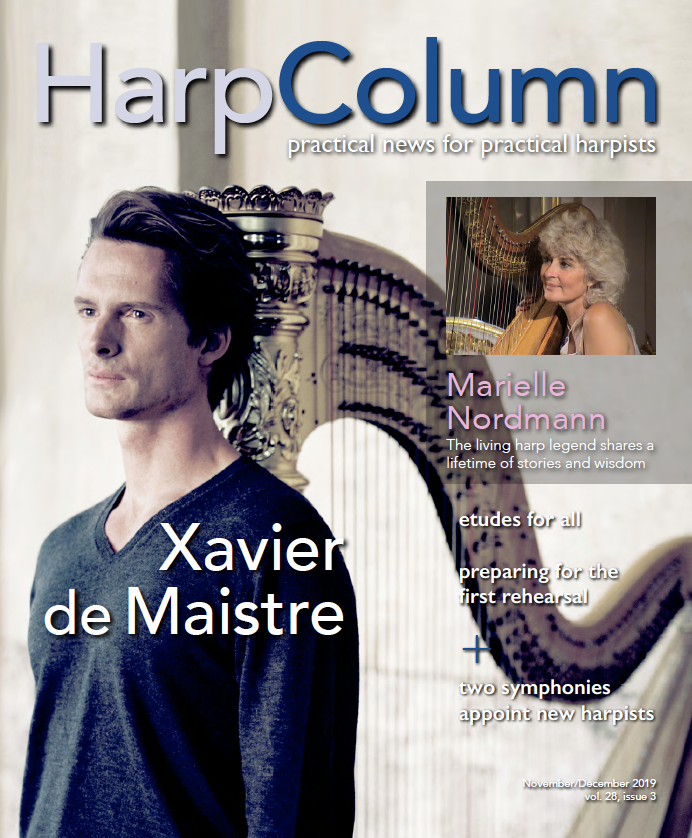
Hal Leonard has published a collection of “accessible solos for both pedal and lever harps” arranged by Mary E. Keppeler entitled First 50 Songs You Should Play on Harp. The book assumes E-flat tuning for lever harps, but they forgot to tell you that one important detail. There are a few instructions from the arranger, the most important being that some notes are written enharmonically. These notes are circled and written this way to preserve the harmonic integrity of the passage.
Lever changes are indicated by diamond-shaped notes, but they are very tiny and easy to miss. Otherwise, the typesetting is easy to read. Pedal changes are written below the staff and some fingering is suggested. Most pieces are at an intermediate level for pedal harp and advanced level for lever harp. (Most of the arrangements are easier to play on pedal harp.) Some page turns are wicked.
Some of these arrangements are very appealing; others are less interesting, usually due to muddy left hand chord voicing. Intervals of thirds in the fifth octave should be avoided, especially twice in one measure (as in “And So It Goes” or a few measures of “Danny Boy”). There are also a few long, empty spaces in some measures, mostly due to so many lever changes (e.g., “Yesterday”).
Although there are some very useful tunes included, the title’s claim is certainly debatable! It’s hard to imagine a situation other than perhaps a baby shower when Brahms “Lullaby” would come in handy, and other than a very rare client request, who wants to play “You Light Up My Life?” Ick. On the other hand, there are some nice arrangements that did not previously exist for lever harp such as “At Last.” This tune has some very pretty harmonies, nice chord voicing, and reasonable lever changes.
“Can You Feel the Love Tonight” is a nice arrangement. The third octave A-flat lever in m. 11 could easily be eliminated without being missed at all (if you skip the right hand A-flat in m. 12). “Could I Have This Dance,” the once-popular Anne Murray hit, is a simple but pleasant arrangement. “Hymne” by Vangelis offers some variety with the left hand accompaniment and no lever changes. The Beatles’ classic, “Here, There, and Everywhere” is quite playable until the bridge where there are numerous lever changes. There is one error at m. 19 and again at m. 31 where the third octave E lever should be flat, not natural. Ms. Keppeler suggests lever harpists omit the repeat to avoid excessive lever changes. Good idea.
“Morning Has Broken” uses the intro and interlude from the popular Cat Stevens version and requires several manageable lever changes. “The Rose” begins with the left hand melody played against the pulsing right hand “hook” from the Bette Midler version. However, Keppeler added some extra left hand notes that are difficult to distinguish from the melody regardless of the rhythmic separation.
Several pieces, including “You Raise Me Up,” “You’ll Be In My Heart (from Tarzan),” “Beauty and the Beast,” “From This Moment On,” and “Time to Say Goodbye” have key changes which can be very challenging on lever harp and sometimes not worth the effort. You can always skip the key change. She did a nice job of arranging Billy Joel’s “Lullabye (Goodnight My Angel)” which is a very chromatic piece, but it is very difficult on lever harp. Despite also being a lullaby, this isn’t cliché like the Brahms.
There are several popular Broadway tunes, including “All I Ask of You” (from Phantom of the Opera), “Bring Him Home” and “I Dreamed a Dream” (from Les Misérables), “Memory” (from CATS), and “Send in the Clowns” (from A Little Night Music).
At a retail price of $19.99, you’ll already have gotten your money’s worth with just these arrangements, as those mentioned still comprise less than half the contents. It’s usually a better value to buy a book than individual arrangements.
Even if you use only a dozen of the selections, this is a useful book and a good value with a broad variety of selections from various genres.
Cindy Horstman has written and published some original solos for pedal harp. The first is “Lullaby,” and it is just two and one-half pages. It is sight-readable for an intermediate player. There are a few easy and well-marked pedal changes. The page turn is easy. There is no fingering, nor is it necessary.
The piece is in A-major and a few harmonics add garnishes. The 6/8 time signature and left hand accompaniment give the piece an easy, rocking feeling. The left hand is the same pattern throughout.
“Carillon Wave” is longer at six pages and more challenging. Also in A-major, this piece starts out very rubato and with some lovely rolled chords. On the second page, the tempo picks up and it becomes upbeat and jazzy. This piece won an honorable mention at the Dallas Chapter of the American Harp Society’s Solo Composition Contest.
You can hear Ms. Horstman play both pieces on her website at cindyhorstman.com, as well as at harpcolumn.com where you can also see a sample of the music. They are downloadable at either website. If you like to support a colleague’s original work, here’s your chance. Best wishes for the New Year! •






